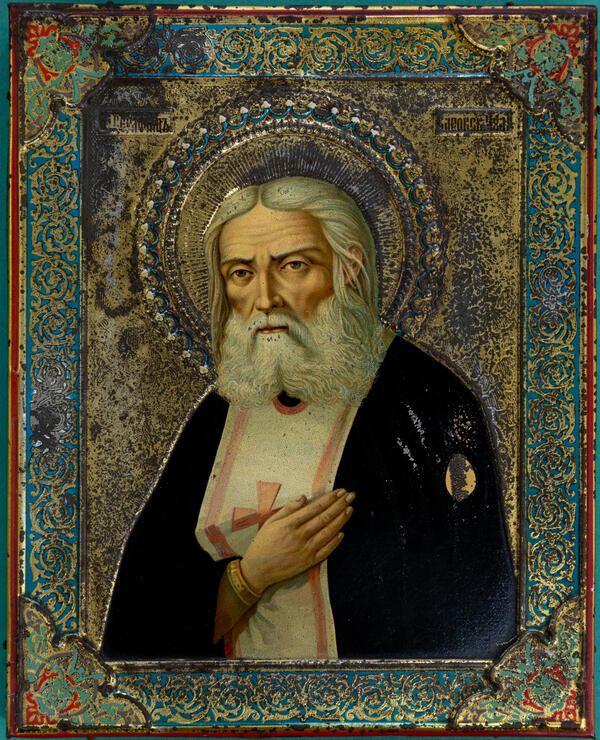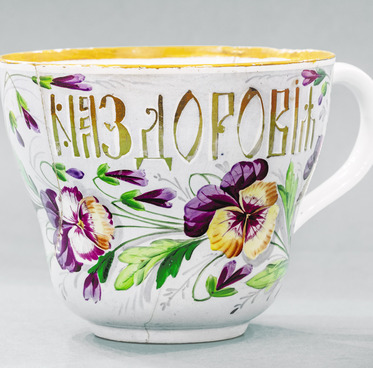The icon was made in 1903 at the Moscow factory Zhako. It is made from wood and stamped brass in the chromolithography method. The icon is framed in percale, a very fine fabric. In the late 19th century, the Moscow factory Zhako was the first to start making icons on brass. Alongside with the Bonaker factory, they were the main manufacturers of stamped brass icons. Zhako factory invited the best masters from Mstera and Palekh, storied centers of icon painting, to work on their steel icons.
Apart from stamped brass, Zhako factory used another method called chromolithography —multicolored stamping. For each color on the icon, they took an individual stamping mold. Twenty or even more molds were needed to make an icon. The molds were made from stone or a zinc slab with a contour of the colored parts. The combination of artistic techniques helped make these icons not too pretentious and drowning in gold.
Seraphim of Sarov was a saint and a hieromonk (priest-monk) at the Sarov Monastery. He founded the Diveyevo Monastery in Nizhny Novgorod. Seraphim of Sarov is one of the most venerated monks in the history of the Russian Church. The icon made at Zhako factory has very well calibrated dimensions, a perfectly treated wooden slab onto which the brass icon is attached. The stamping and imprinting are done with great precision.
The icon is distinctly clear and colorful which makes it stand out among older icons painted by hand.
Images on icons are always precise and expressive. They impress with exquisite ornaments and vivid stylized patterns. This product resembles hand-painted icons in expensive enameled plating with sparkling gilding and imitation jewels.
One could buy an icon like this one in Moscow and other cities across Russia. Manufacturers of brass icons used all the latest technology in their production, such as electroplating, stamping, chromolithography, and imprinting. These new works of religious art fascinated people of the early 20th century who weren’t used to seeing such richly decorated and elegant icons.
Apart from stamped brass, Zhako factory used another method called chromolithography —multicolored stamping. For each color on the icon, they took an individual stamping mold. Twenty or even more molds were needed to make an icon. The molds were made from stone or a zinc slab with a contour of the colored parts. The combination of artistic techniques helped make these icons not too pretentious and drowning in gold.
Seraphim of Sarov was a saint and a hieromonk (priest-monk) at the Sarov Monastery. He founded the Diveyevo Monastery in Nizhny Novgorod. Seraphim of Sarov is one of the most venerated monks in the history of the Russian Church. The icon made at Zhako factory has very well calibrated dimensions, a perfectly treated wooden slab onto which the brass icon is attached. The stamping and imprinting are done with great precision.
The icon is distinctly clear and colorful which makes it stand out among older icons painted by hand.
Images on icons are always precise and expressive. They impress with exquisite ornaments and vivid stylized patterns. This product resembles hand-painted icons in expensive enameled plating with sparkling gilding and imitation jewels.
One could buy an icon like this one in Moscow and other cities across Russia. Manufacturers of brass icons used all the latest technology in their production, such as electroplating, stamping, chromolithography, and imprinting. These new works of religious art fascinated people of the early 20th century who weren’t used to seeing such richly decorated and elegant icons.



